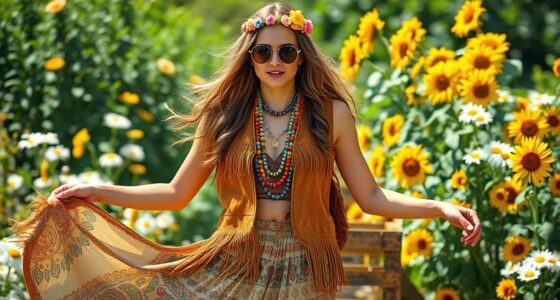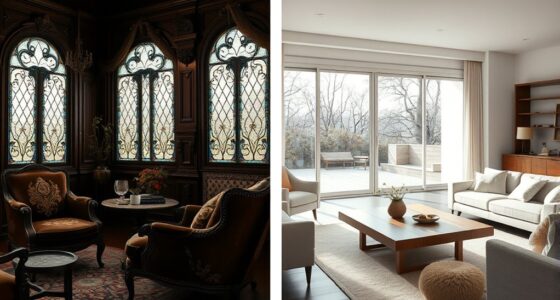French country style has deep roots in rural regions, drawing inspiration from traditional farmhouses and medieval chateaus that emphasize simplicity, durability, and natural textures. You’ll notice warm earthy tones, rustic stonework, and handcrafted details like wrought iron accents and weathered wood. It’s all about creating cozy, timeless spaces that reflect regional craftsmanship and rural life. Exploring further reveals how these historic elements shape the charming, authentic look that defines this enthralling style.
Key Takeaways
- Originates from rural French regions emphasizing practicality, simplicity, and regional craftsmanship rooted in farmhouses and medieval chateaus.
- Features rustic stonework, pitched clay tile roofs, arched doorways, and tall, narrow windows for a charming, authentic look.
- Uses warm, earthy color palettes like terracotta and taupe, combined with natural materials such as weathered wood and stone.
- Decor highlights ornate carvings, soft pastels, vintage accessories, and layered textiles for a cozy, artisanal atmosphere.
- Inspired by rural life, traditional crafts, and regional resources, emphasizing authenticity, durability, and regional heritage.
Origins and Historical Development of French Country Style
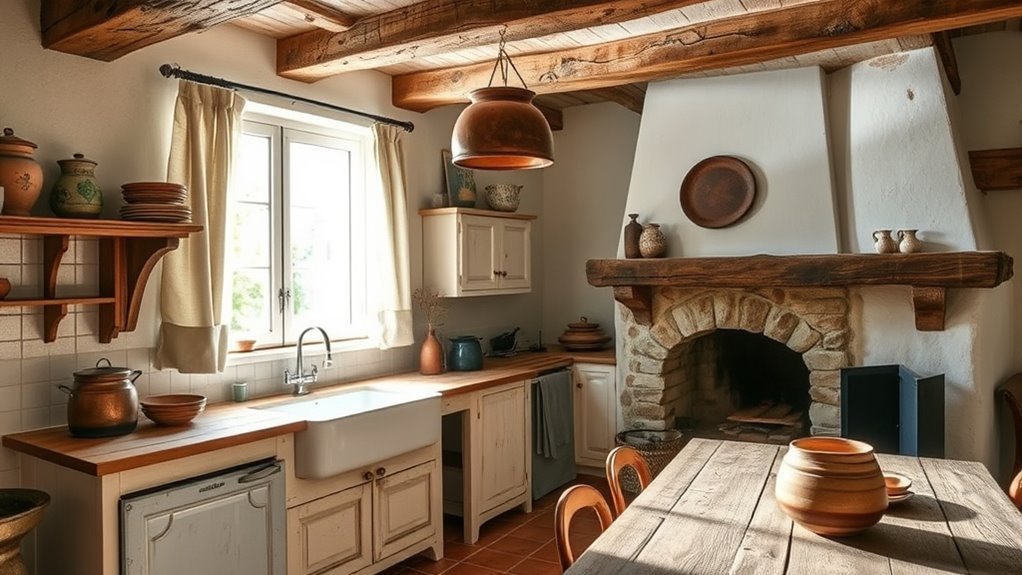
French Country style has its roots in the rustic charm of rural regions in France, where practicality and simplicity shaped everyday life. You can trace its origins back to medieval chateaus, which combined durability with understated elegance. These grand structures influenced local building practices, emphasizing stonework and functional design. Over time, this style spread across provincial villages, where farmers and artisans adapted chateau elements into cozy, practical homes. The style reflects a balance of tradition, quiet elegance, and a focus on natural materials. As you explore French country interiors, you’ll notice how history and regional influences blend seamlessly, creating a timeless aesthetic rooted in rural life. This evolution highlights the style’s deep connection to France’s historical rural communities and their enduring charm. Additionally, the use of **natural materials** like wood and stone further emphasizes its rustic origins and timeless appeal.
Key Architectural Elements and Structures
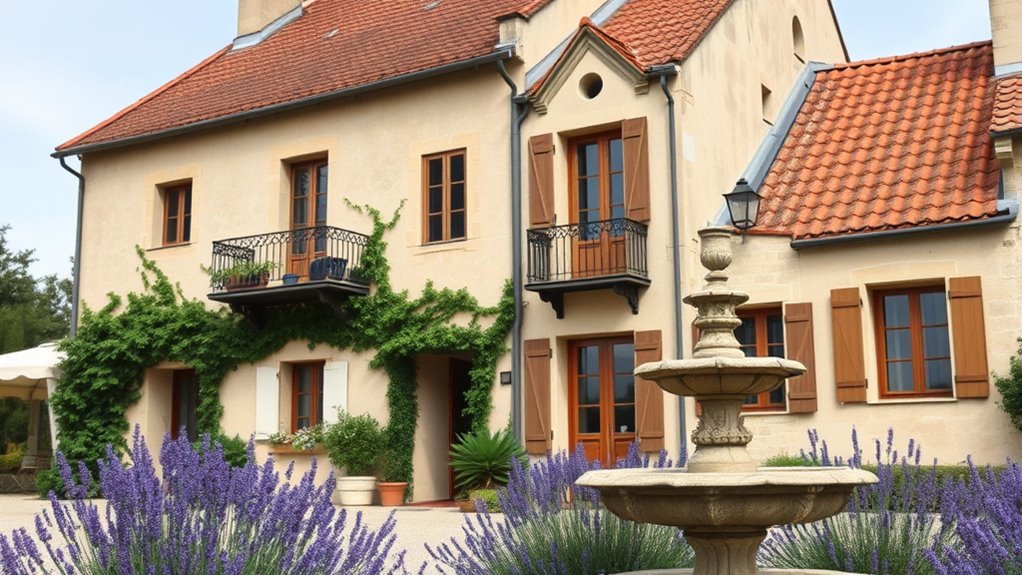
What are the defining architectural features that bring French country style to life? You’ll notice rustic stonework, which creates a warm, textured appearance that emphasizes natural materials. These stones often form the exterior walls and chimneys, giving homes a timeless, grounded feel. Wrought iron details are also essential; you’ll see these in decorative railings, lanterns, and window grilles, adding an elegant, handcrafted touch. The structures typically feature pitched roofs with clay tiles, arched doorways, and tall, narrow windows that invite soft natural light inside. These elements combine to produce a charming, rustic aesthetic rooted in tradition. Together, rustic stonework and wrought iron details define the authentic look, capturing the essence of French country architecture’s warm, inviting character.
Signature Color Palettes and Materials
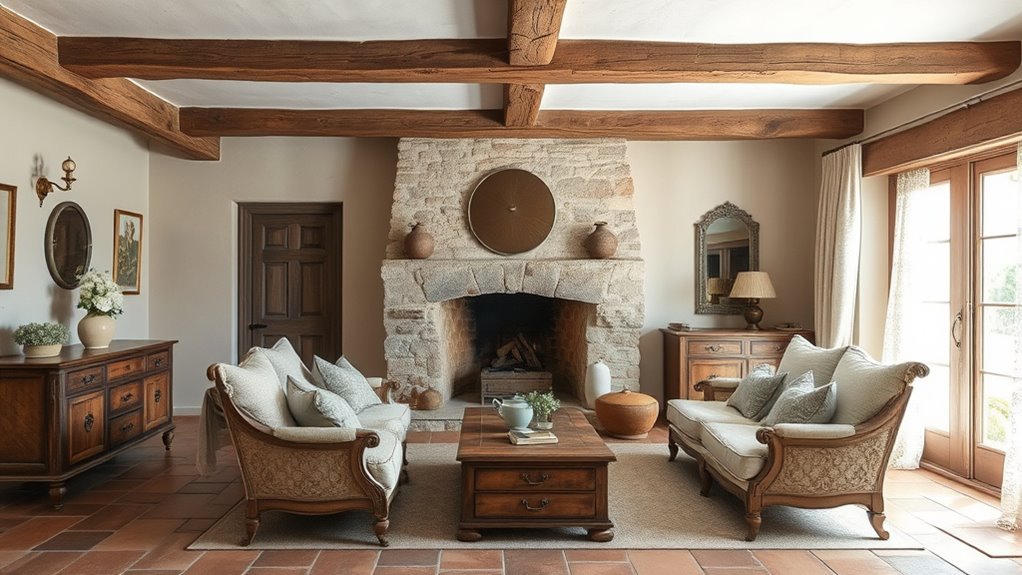
A signature color palette for French country style typically features warm, earthy tones that evoke a cozy, inviting atmosphere. You’ll often see shades like soft terracotta, muted ochre, and warm taupe, which enhance the rustic charm of the space. These colors work in harmony with natural textures, such as weathered wood, stone, and terracotta tiles, creating a genuine sense of authenticity. To deepen your understanding, consider these key points: 1. Warm, earthy tones foster a welcoming environment rooted in tradition. 2. Natural textures amplify rustic charm and add tactile interest. 3. Harmonizing colors and materials creates a timeless, cohesive look. Incorporating skin-friendly materials can also enhance the comfort and durability of your space, making it both beautiful and functional.
Distinctive Furniture and Decor Features

French country style features furniture with ornate carvings and graceful curves that add elegance to any space. You’ll notice the use of soft pastel colors in decor and upholstery, creating a warm, inviting atmosphere. These distinctive elements combine to give the style its timeless charm and rustic sophistication.
Ornate Carvings and Curves
Ornate carvings and graceful curves define the character of French country furniture and decor. You’ll notice the intricate woodwork that highlights craftsmanship and attention to detail, especially in pieces with decorative moldings. These details add elegance and a sense of history to your space. To fully appreciate this style, keep in mind:
- The use of detailed, hand-carved motifs that evoke a sense of artistry.
- The flowing curves that soften furniture edges and create visual harmony.
- The emphasis on decorative moldings that frame and enhance furniture surfaces, adding depth and sophistication.
These features reflect a commitment to craftsmanship and tradition, making your home feel both charming and timeless. Ornate carvings and curves are the soul of French country style’s distinctive furniture and decor.
Pastel Color Palettes
Soft, muted hues characterize the pastel color palettes that define French country furniture and decor. These gentle tones—pale blues, soft pinks, and creamy yellows—create a calming, inviting atmosphere. They often reflect the natural elements found in garden design, blending seamlessly with floral arrangements and rustic accents. Pastels also echo culinary influences, reminiscent of fresh pastries and delicate desserts common in French kitchens. When choosing furniture or decor, you’ll notice these colors enhance the sense of lightness and airiness, making spaces feel larger and more open. This color scheme fosters a relaxed, charming ambiance, perfect for a cozy country home. By incorporating pastels, you connect the aesthetic to both the outdoors and traditional French culinary traditions, enriching your space’s authentic feel. Additionally, incorporating vintage textiles and accessories can further enhance the nostalgic charm characteristic of French country interiors.
Influence of Rural French Life and Traditions

Rural life in France deeply shapes the country’s aesthetic, infusing it with a sense of authenticity and simplicity. This influence is evident in the use of rural farming traditions, where practical design meets rustic charm. Regional craft influences also play a crucial role, reflecting local materials and techniques. To understand this connection, consider these aspects: 1. Preservation of traditional crafts** that showcase regional artistry and skills. 2. Use of natural materials like stone, wood, and clay, rooted in local resources. 3. Design elements inspired by rural landscapes, such as exposed beams and handcrafted textiles. Incorporating local artisan techniques further emphasizes the handcrafted quality that characterizes French country decor. These features create a sense of history and groundedness, reminding you of France’s agrarian roots. Embracing these influences helps maintain the authenticity and timeless appeal of French country style**.
Modern Interpretations and Variations

While traditional French country style celebrates rustic authenticity, contemporary interpretations bring fresh energy and versatility to the look. Modern adaptations incorporate sleek lines, neutral palettes, and minimalist touches, aligning with current interior styling trends. You might see rustic charm blended with modern materials like glass and steel, creating a balanced mix of old and new. These variations emphasize open spaces, natural light, and subtle elegance, making the style more adaptable to diverse interiors. You can also experiment with color schemes, combining traditional warm tones with cooler shades for a contemporary twist. Additionally, understanding interior design trends can help you incorporate these updates seamlessly. Overall, these updates maintain the spirit of French country charm while reflecting today’s design sensibilities, allowing you to create a space that feels both timeless and current.
Tips for Incorporating French Country Charm Into Your Home
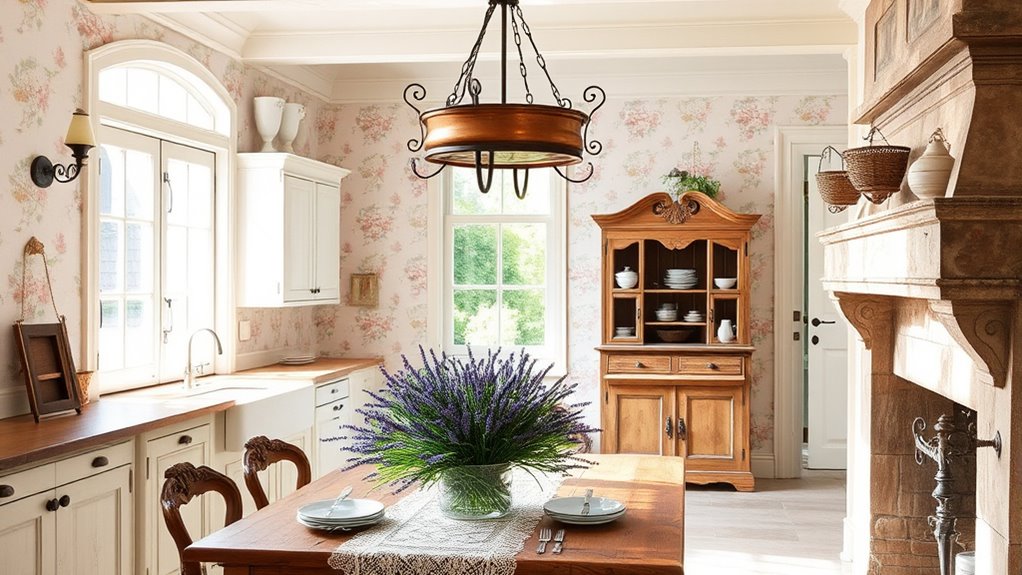
To infuse your home with French country charm, start by choosing furniture and decor that reflect rustic elegance, such as distressed wood pieces, wrought iron accents, and vintage-inspired textiles. Incorporate vintage accessories like antique lanterns or ornate mirrors to add authenticity. Use floral arrangements with soft, pastel blooms to bring freshness and warmth. To deepen the charm, consider these tips: key elements of farmhouse decor, including mixing textures—combine rough-hewn wood with smooth ceramics for visual interest. Add layers of textiles, such as linen curtains and cozy throws, for comfort. Display vintage accessories and floral arrangements thoughtfully to create focal points. These elements work together to evoke a timeless, cozy French country atmosphere, making your space feel inviting and charming.
Frequently Asked Questions
How Can I Blend French Country Style With Modern Interiors?
To blend French country style with modern interiors, you should incorporate antique furniture pieces that add charm and history. Use a rustic color palette with soft, muted tones like creams, blues, and earthy shades to create warmth. Keep the space open and uncluttered, mixing vintage accents with sleek, contemporary elements. This balance allows the timeless elegance of French country style to complement your modern aesthetic seamlessly.
What Are Common Misconceptions About French Country Design?
You might think French country design is all about fancy chandeliers and endless lavender fields, but it’s really about rustic elegance and vintage charm. Misconceptions include believing it’s overly ornate or stuffy. In reality, it’s cozy, inviting, and effortlessly chic. You don’t need a chateau to achieve this look—just warm woods, soft colors, and a touch of old-world charm. It’s about blending comfort with timeless style, not decorating like a castle.
Are There Specific Regions in France Known for This Style?
You’ll find French country style especially prominent in regions like Provence vineyards and Alsace villages. Provence’s sun-drenched landscapes inspire rustic, sun-washed interiors, while Alsace’s charming villages feature timbered houses and cozy, inviting decor. These areas showcase the authentic roots of French country design, blending rural elegance with natural materials. So, if you’re aiming for this style, exploring Provence and Alsace can give you the most genuine inspiration and regional flavor.
How Does French Country Style Adapt to Urban Homes?
Did you know that over 60% of urban homes now incorporate French country style? You can adapt this look by blending rustic charm with vintage accents, making small spaces feel cozy and inviting. Use distressed furniture, soft color palettes, and antique accessories to achieve this aesthetic. Even in city settings, you’ll enjoy the warmth and timeless elegance of French country style, transforming your home into a charming retreat.
What Budget-Friendly Tips Exist for Achieving This Look?
To achieve a French country look on a budget, start with antique furniture pieces or vintage finds to add charm without the cost. Use rustic finishes like distressed paint or natural wood to create warmth and authenticity. Incorporate soft, muted colors and simple accessories such as wrought iron accents or floral textiles. These tips help you capture the elegance and cozy feel of French country style without overspending.
Conclusion
Embracing French country style is like wrapping your home in a warm, timeless hug. Its roots run deep, blending rustic charm with elegant simplicity. By incorporating signature colors, vintage furniture, and heartfelt details, you create a space that feels both inviting and authentic. Let this style inspire you to transform your home into a cozy retreat—where every corner whispers stories of tradition and beauty, just like a cherished family heirloom passed down through generations.




